- Subscribe to RSS Feed
- Mark Topic as New
- Mark Topic as Read
- Float this Topic for Current User
- Bookmark
- Subscribe
- Mute
- Printer Friendly Page
Frequently Asked Questions (FAQ): NI 9683 Single-Board RIO General Purpose Inverter Controller (GPIC)
09-04-2012
10:48 AM
- last edited on
05-10-2024
09:55 AM
by
![]() Content Cleaner
Content Cleaner
- Mark as New
- Bookmark
- Subscribe
- Mute
- Subscribe to RSS Feed
- Permalink
- Report to a Moderator
Here are responses to common frequently asked questions (FAQs) regarding the NI 9683 Single-Board RIO General Purpose Inverter Controller (GPIC). Please respond to this thread with your own questions and we can use it as a living FAQ document.
-
What is the NI Single-Board RIO General Purpose Inverter Controller (GPIC?
With the NI Single-Board RIO GPIC, you can bring grid-tied power electronic systems to market with significantly lower cost and risk. The FPGA-based system is designed to meet the cost, I/O, and performance needs of most high-volume commercial power electronics control applications, including DC-to-AC, AC-to-DC, DC-to-DC, and AC-to-AC converters for smart-grid flexible AC transmission systems (FACTS), renewable energy generation, energy storage, and variable speed drive applications. Learn more...
-
Where can I find the factsheet and getting started examples?
NI Power Electronics Control Design V Training Course
NI sbRIO GPIC Evaluation Kit - Opening the Box and Getting Started!
Factsheet - NI Single-Board RIO General Purpose Inverter Controller (GPIC)
GPIC Example 1: Field Oriented Getting Started Example Code for the NI sbRIO GPIC
GPIC Example 2: Power Electronics Design Guide Example
- Where can I find a list of required and recommended development software for purchase or evaluation?
The minimum required software for the NI GPIC includes NI LabVIEW, NI LabVIEW Real-Time, NI LabVIEW FPGA, and the NI Device Drivers 2013.02 (or higher). For a complete list of recommended software, follow the link below:
- Where can I find user manuals and dimensional drawings?
NI sbRIO-9606 OEM Operating Instructions and Specifications (Dimensional Drawings)
NI 9683 GPIC User Guide and Specifications (Dimensional Drawings)
NI-9695 sbRIO Thermal Solution Installation Instructions (Dimensional Drawings)
-
Do you have an evaluation kit for the NI sbRIO GPIC? What does it contain?
Yes.
The kit is only orderable quantity 1-2 (for evaluation only) and includes the following:
- NI 9683 General Purpose Inverter Controller (learn more or download the user manual),
- sbRIO-9606 FPGA/processor board (user manual),
- PS-2 24 VDC power supply with 2-position mini-fit power plug for sbRIO-9606,
- sbRIO-9606 2-position mini-fit power plug and pigtail wire assembly (12" length)- useful if you plan to power the sbRIO-9606 with 9–30 VDC from your mating board by connecting the pigtail leads to screw terminals on your mating board,
- NI 9695 Thermal Kit heat spreader for FPGA, processor and RAM,
- Standoffs (0.380" length) and 4-40 (0.25" length) screws (with nylon patch on threads for vibration robustness) for mating the NI 9683 mezzanine card to the sbRIO 9606. Note: These standoffs are special length and not generally available, so they are also included in the NI sbRIO GPIC OEM kit for high volume commercial deployment.
- Standoffs (1.5" length) and screws for setting the stack on a table- the standoffs are long enough that it can stand in either orientiation (bottom of 9683 facing up up or top of 9606 facing up),
- Two 10 position IDC female to 9-position DSUB male connectors for the sbRIO-9606 CAN IDC Header (CAN0) and RS-232 Serial IDC Header (COM1),
- NI 9683 GPIC and NI sbRIO-9606 user manual and NI screwdriver,
- DVD including 45-day LabVIEW Embedded Platform Evaluation Software (LABVIEW, REAL-TIME, FPGA, RIO) which includes the NI Device Driver DVD. Note: The initial trial works for 7 days but can be extended to 45 days by registering. Note: The NI Device Driver DVD contains the NI-RIO driver, which is required. You can also request a free copy of this platform evaluation DVD at ni.com/trylabview.
- DVD containing 30-day evaluation versions of the NI Circuit Design Suite (containing NI Multisim and Ultiboard)
- NI RIO driver DVD.
Note:
- The Power Electronics Design Guide Code is downloaded online. You can also download getting started example code for the NI GPIC here.
-
Where can I find interface mating board templates?
The typical design flow for power electronics product development is shown below. First, the digital control code and analog power electronics control circuitry are co-simulated to design and test the energy system using NI Multisim and LabVIEW co-simulation capabilities. Then a custom interface circuit board is developed, often using an existing template as a starting point. This enables the development team to provide custom signal conditioning and mechanical connector layout to meet the application specific requirements, as in the 50 kVA wind-turbine back-to-back power converter shown below.
Mating PCB Example 1: Provides screw-terminal breakout for all 134 GPIC I/O signals and a SEMIKRON SKiiP 3 interface connector:
NI Single-Board RIO General Purpose Inverter Controller (GPIC) - Mating PCB Board Template (Multisim...
Note: The trace width on the relay control digital output traces in the example above is insufficient to handle the 8 Amp inrush capability of the GPIC relay control digital outputs. You must increase the width of those traces. Also, you must use external flyback diodes to protect the relay control outputs and ensure your cabling to the contactor relays has sufficient current handling ampacity. For more information, see the topic "Protecting the Relay Control Digital Outputs from Flyback Voltages" in the NI 9683 user manual.
Mating PCB Example 2: Provides two 5 A, 50 V 3-phase inverters connected in a back-to-back topology
New NI GPIC back-to-back 3-phase inverter research board - develop at mini-scale, deploy at full sca...
3-Phase Back-to-Back Inverter Research Board with NI Multisim and the NI GPIC

-
Where can I find case studies and quotes for LabVIEW RIO based power electronics control? What has been the feedback from developers using the NI power electronics toolchain, GPIC and new LabVIEW FPGA/Multisim co-simulation tools?
Here are a few examples.
E-Power Swiss 500 kW Solar Inverters - One Year Development Cycle for Design, Prototyping, Certifica...
Feedback from Eaton Corporation Lead Engineer for Power Systems & Architectures,Yakov Familiant
NREL: A Better Way to Connect Solar, Wind to the Grid
LabVIEW FPGA Control of an Electric Vehicle Converter with Ultracaps and Batteries
Lockheed Martin Intelligent Microgrid NI CompactRIO Distributed Resource Control Systems (DRCs)
Xtreme Power NI Single-Board RIO Energy Storage Control Systems
Most customers are seeing at least a 2-3 times reduction in their non-recurring engineering development cost by using the NI GPIC and LabVIEW graphical system design tools, compared to the conventional embedded design process of making a custom circuit board containing DSP and/or FPGA and I/O. Using the new platform and method for development, you can expect to save at least 114 person-months of engineering cost per design and complete your projects less than half the time. That's an average of $950,000 cost savings per design, assuming $100k/person/year including overhead.
-
I am just getting started. Which introductory tutorial videos do you recommend?
NI sbRIO GPIC Evaluation Kit - Opening the Box and Getting Started!
If you are new to LabVIEW, you may also wish to familiarize yourself with the basics of the graphical programming environment by viewing the 3-4 minute introductory video tutorials here:
Introduction to NI LabVIEW
The short videos in the tutorial above will give you a good idea of the basics of getting around inside NI LabVIEW (download now).
Hands On Tutorial - Getting Started with Co-Simulation using NI Multisim and LabVIEW FPGA
Introduction to Power Electronics Co-Simulation with Multisim and LabVIEW
Getting Started with the NI General Purpose Inverter Controller
Brief Introduction to Real-Time HIL Simulation of Power Converters
-
Where can I download getting started tutorials, example code and IP cores?
NI Power Electronics Control Design V Training Course
The following design guide ZIP file contains a wealth of resources including example code, papers and other resources for power electronics desktop co-simulation, FPGA-based control, and real-time HIL simulation:
Power Electronics Design Guide: Read PDF and Download Example Code
Download the NI GPIC Field Oriented Control Getting Started Code
Comprehensive NI Power Electronics Platform Guide
-
Do you have training videos I can watch or online courses I can take?
Yes. Here are some recommended training videos and free course material. For paid courses, which can be taken in person or online, visit ni.com/training.
Introduction to Multisim: Learn to Capture and Simulate in Less Than 30 Minutes
Hands On Tutorial - Getting Started with Co-Simulation using NI Multisim and LabVIEW FPGA
-
Where can I download all the NI development tools? Are evaluation versions available?
Yes, fully functional evaluation versions are available which can be activated upon purchase without reinstallation. Below are links to evaluation versions for all the NI power electronics developments and also the drivers for NI sbRIO General Purpose Inverter Controller (GPIC). The evaluation versions of the tools will work for 7 days, and then require you to register to extend your evaluation to 45 days.
Download the NI Power Electronics Evaluation Software and Design Guide Code
-
From an engineering management perspective, how does the development cost of using the NI sbRIO GPIC compare to the cost of traditional full custom PCB design with conventional DSP and FPGA chips?
In terms of non-recurring engineering development cost (NRE), going with the GPIC and NI graphical system design toolchain is strikingly less expensive. UBM/EETimes recently sent their embedded market survey to around a thousand NI LabVIEW FPGA/RT RIO embedded systems development teams. The survey results for the items below (margin of error +/- 3.9-4.3%) show a stark difference between the performance metrics and development cost for LabVIEW/RIO teams compared to the general/traditional embedded systems market (typically text based programming tools and full custom PCB design). For example, the average NRE to complete the embedded design is 30 person-months for LabVIEW/RIO teams compared to 144 person-months for the overall embedded market. Assuming skilled embedded developers costing $100k/year with overhead (facilities, health care, etc.), the average LabVIEW/RIO embedded systems design project costs $250k compared to $1.2M for the overall embedded market- an average NRE cost savings of $950k per design.
|
|
NI Embedded Customers (2012)1 |
EETimes Overall Embedded Market (2012)2 |
Ratio |
|
Average Development Team Size (HW, SW, Firmware Engineers) |
4.8 |
11.5 | 2.4 |
|
Average Months to Complete Project |
6.2 |
12.5 | 2.0 |
|
Average Person-Months to Complete Project |
30 |
144 |
4.8 (average of 114 person-month savings per design) |
|
Average Development Cost (assuming $100k/person/year including overhead) |
$248,000 |
$1,198,000 |
4.8 (average $950,000 cost savings per design) |
|
Percent of Projects Completed On or Ahead of Schedule |
58% of NI customers |
42% of embedded market |
0.7 |
|
Percent of Projects Completed Behind Schedule/Late |
38% of NI customers |
55% of embedded market |
1.4 |
NOTE1: The EETimes study was a global Email/web study including over 1,700 responses from embedded engineers from Americas, Europe and Asia
NOTE2: The NI study was a global Email/web study including over 1,000 responses NI embedded customers from Americas, Europe and Asia
Compared to traditional embedded design teams, NI RIO and LabVIEW FPGA/RT embedded systems design teams:
o Complete projects in half the time as EET developers do (average 6.2 months for LabVIEW embedded designs versus 12.5 months for overall embedded market)
o Complete more projects on or ahead of time with fewer late projects (58% of LabVIEW embedded designs complete on or ahead of schedule versus 42% for overall embedded market)
o Complete projects using a team that is 2.4 times smaller (average of 4.8 compared to 11.5 embedded HW/SW/Firmware engineers)
o Complete projects with 114 fewer person-months of non-recurring engineering (NRE) development cost
o Are younger and less experienced (fewer years out of school)
-
Can you give me a link to all of the quarterly IEEE Spectrum webcasts in the ongoing Smart Grid Power Electronics Webcast Series?
Here are links to the archived webcast recordings in reverse chronological order:
Real-Time HIL Simulation of Grid-Tied Switched-Mode Power Systems
A New System-Level Design Methodology and Platform for FPGA-based Power Electronics Control
Modernist Circuit Topologies & Transistors for Smart Grid Power Electronics
Power Converter Controller Design for Smart Grid Power Electronics
Accelerating Development of Smart Grid Power Electronics Control Systems with RCP and HIL Techniques
- Where can I find LabVIEW FPGA IP blocks for field-oriented control, such as Park and Clarke transforms and Space-Vector Pulse-Width Modulation (SVPWM)?
You can find a post describing the LabVIEW FPGA IP blocks included with the NI SoftMotion Module here. This includes Space-Vector PWM:
Screenshots and comments on the new power electronics IP library for LabVIEW FPGA (included with NI ...
The NI SoftMotion Help documentation provides great explanation of these IP blocks and how to use them:
NI SoftMotion Module Help - Space Vector Modulation and Clarke/Park Transforms
You can also find versions of the Park and Clarke transform blocks in the GPIC example code here. Watch the video tutorial for a description:
Example Code: Getting Started with the NI Single-Board RIO General Purpose Inverter Controller (GPIC...
-
It's common to sample the analog inputs for voltage and current sensors at a specific instant during the pulse width modulation cycle, to acquire an approximation of the average current and minimize the effects of switching noise, etc. Is it possible to synchronize the simultaneous analog inputs on the NI Single-Board RIO GPIC with the modulator?
Yes.The 16 simultaneous analog inputs can be triggered at a specific moment in the pulse width modulation cycle, typically as you mentioned at the mid-point of the PWM on time. For example, the PWM block in the single-phase inverter example included with the Power Electronics Design Guide includes a Boolean output for triggering the analog input operation called "Sample Clock." This IP core is intended for full bridge inverters- typically used with motor drives or single phase inverters. The rising edge is detected in a separate single-cycle timed loop, which exits when the trigger occurs, followed by the analog input operation in the second frame of a sequence.
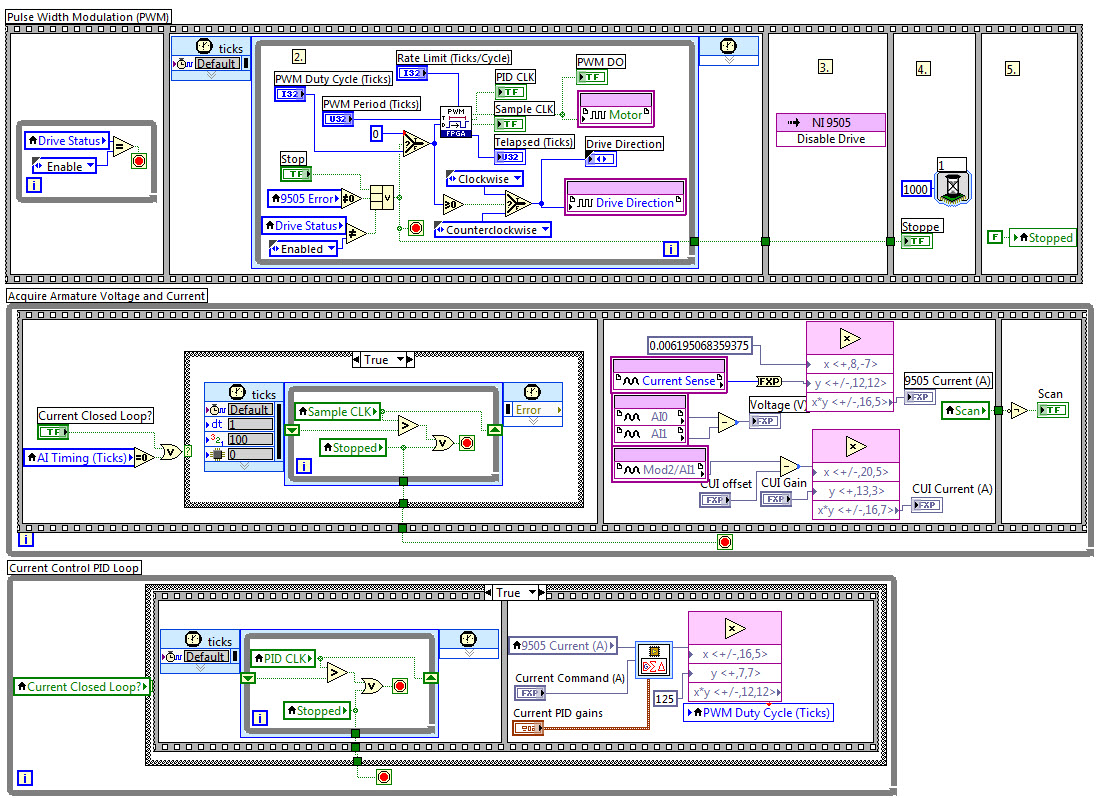
The screenshot above is from "CompactRIO DC Motor Control and SysID (FPGA) v06.vi", included in an example design project from 2007.
You can find the latest version of these IP cores including functional simulations and Multisim co-simulations here:
Download Multisim 12 & LabVIEW FPGA power electronics cosimulation tools, code and videos
Below is a tutorial that explains the FPGA code for using the "PID Clock" signal, which is used in a similar way to the "Sample Clock" signal to trigger execution of PID control.
See this tutorial from 2007 for more information.
PDF: LabVIEW FPGA algorithm development best practices
Code:
http://www.ni.com/pdf/labview/us/compactrio_motor_control_basics.pdf
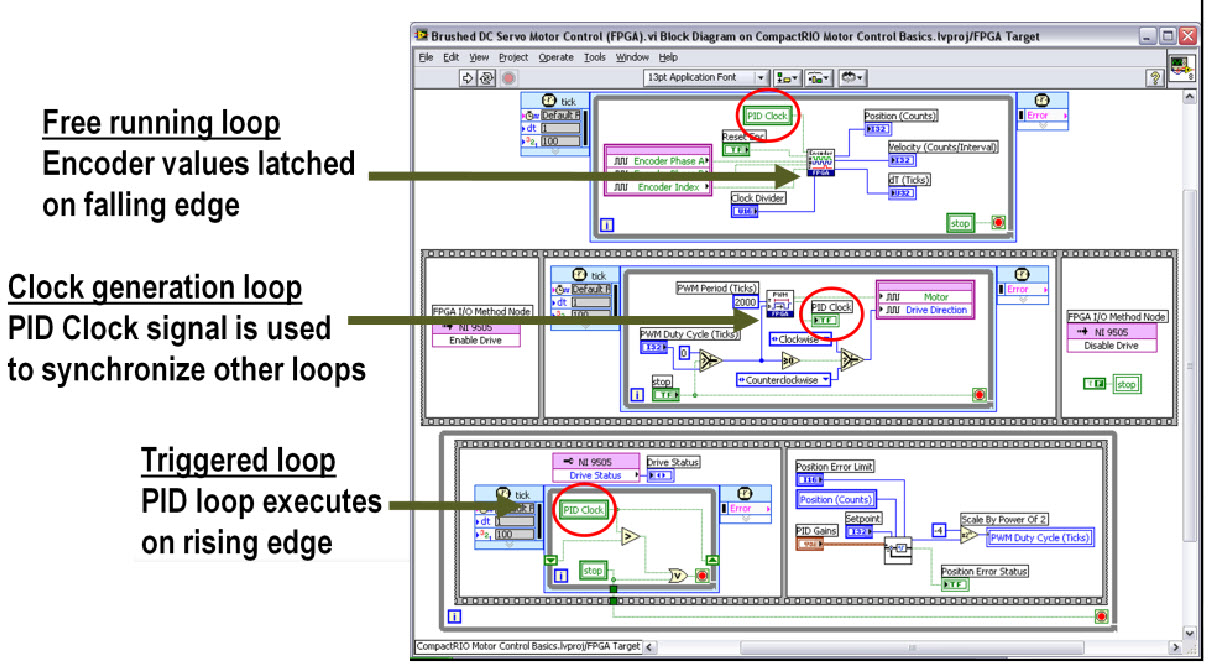
- Can we control different inverter topologies (H5,HERIC,Bridge type etc) using the NI GPIC board? If yes, How?
Yes. Because the NI sbRIO GPIC is based on a user reconfigurable FPGA containing 58 built-in DSP cores with nanosecond communication between the internal DSPs and the programmable FPGA fabric, the GPIC is well suited to control any power converter topology. The availability of the reconfigurable FPGA fabric enables the developer to create advanced pulse width modulation schemes that are highly optimized for the converter topology to increase the energy efficiency, improve the THD and extend the lifetime of critical components such as the IGBTs, capacitors, etc.
We designed the NI sbRIO GPIC to handle the I/O directly for any topology with up to 14 IGBTs. Most common are topologies with 6 or 4 IGBTs per NI sbRIO GPIC. For topologies with more IGBTs than 14, the NI sbRIO GPIC controllers typically use FPGA-to-FPGA communication via the LVTTL lines with a signal type of choice (differential line drivers, fiber optic transceivers, etc.)
Below is a diagram showing (at the bottom) how the different I/O types on the GPIC typically map to I/O on the custom, user defined mating board developed by the customer. This template is the typical starting point for creating a custom mating board with the signal connections, locations and connector types optimized for the specific mechanical enclosure of the application.
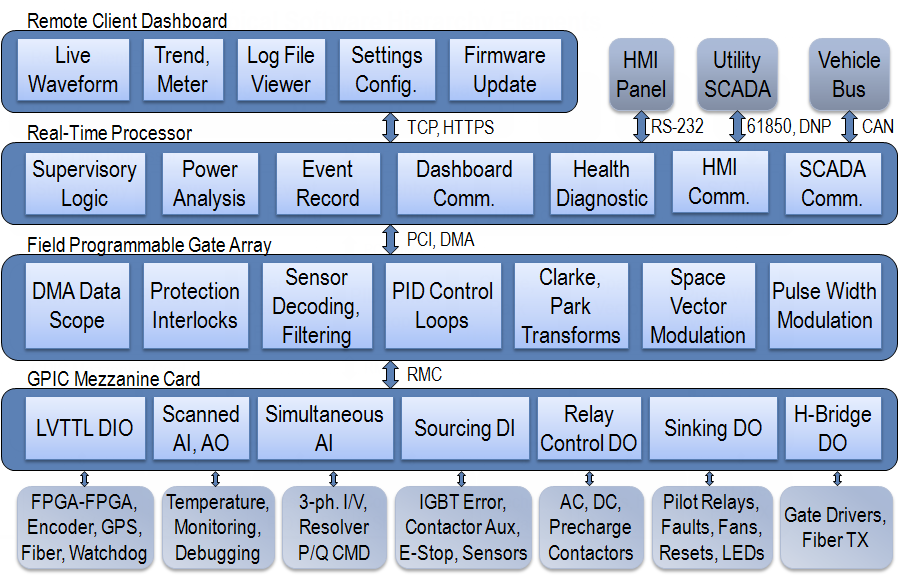
-
Can we configure the NI GPIC for single phase?
Yes. See the single-phase H-bridge inverter example included in the Power Electronics Design Guide.
Download Multisim 12 & LabVIEW FPGA power electronics cosimulation tools, code and videos
- Can we apply different controlling algorithms (Space Vector Modulation, Sine-triangle, etc)?
Yes. A competitive advantage for NI sbRIO GPIC developers, as compared to those using traditional DSPs, is the ability to do these custom modulation schemes using LabVIEW FPGA programming and test/validate them on the desktop before compiling to FPGA hardware using a high fidelity analog/digital co-simulation environment.
For sine-triangle PWM examples, see the Power Electronics Design Guide mentioned above. Here is a link to the PDF guide, which can be viewed without needing to install the tools.
Design Guide to Power Electronics Co-Simulation with Multisim and LabVIEW
For Space-Vector PWM (SVM), customers should purchase NI SoftMotion, which includes the IP for LabVIEW FPGA. See the second page of the GPIC factsheet for a screenshot of the Field Oriented Control with Space-Vector PWM IP that's included with NI SoftMotion.
NI Single-Board RIO General Purpose Inverter Controller (GPIC) - Factsheet
-
Can we assess the performace of an existing inverter using this board?? For this we would need to interface with the inverter? What is the way this would be normally done?
Yes, the NI sbRIO GPIC does contain all of the I/O types necessary for characterizing an external inverter. However, it's actually more common to use a Multicore CompactRIO (cRIO-9082) for this type of application, due to it's performance, which is useful for acquiring waveforms at high speed and performing electrical power analysis using the LabVIEW Electrical Power Suite 2012 (see link above).
-
Is a filter circuit in built on the board?
No. However, the simultaneous analog inputs have basic 210 kHz -3 dB bandwidth filtering. If analog filters are needed, most developers put them on their custom mating board close to the analog inputs. Also, shunt resistors on the custom mating board are very common, typically for converting current signals from LEM type voltage or current sensors to +/- 5 V for the NI sbRIO GPIC simultaneous analog inputs. This current shunt and/or filter circuitry should be placed close to the simultaneous analog inputs on the mating board. See the NI 9683 user manual for details.
The NI Single-Board RIO General Purpose Inverter Controller (GPIC) user manual is online here:
NI 9683 User Guide and Specifications
- What versions of the NI sbRIO processor/FPGA board are compatible with the NI 9683 GPIC mezzanine board?
The NI 9683 GPIC daughter card is compatible with the NI 9606 (Spartan-6 LX45 FPGA containing 58 DSP cores) and NI 9605 (Spartan-6 LX25 FPGA containing 38 DSP cores) single-board RIO control boards. The NI GPIC Evaluation Kit and NI GPIC OEM Kit include the NI 9606 and NI 9683 cards. You can also independently order the NI 9683 GPIC daughter card for use with the NI 9605.
- What is the maximum rating of load that can be driven from this board (single phase as well as three phase)?
Just to be clear, the NI sbRIO GPIC contains only low voltage signals and all isolation must be done externally in the gate driver and sensor circuitry. You should never bring high voltage signals to the NI sbRIO GPIC board directly without external isolation.
The gate command signal outputs (half-bridge DO) are designed for push-pull compatibility with common gate drivers such as Semikron SKiiP 3, CONCEPT Econodual, AgileSwitch Econodual as so on. There is a 100 Ohm series resistor in the path for compatibility and impedance matching reasons, particularly due to the capacitance of SKiiP 3 receiver circuitry.
The four relay control outputs in the NI sbRIO GPIC are rated for 0.5 Amps continuous, and 8 Amps of inrush current.
See the NI GPIC Factsheet for details:
NI Single-Board RIO General Purpose Inverter Controller (GPIC) - Factsheet
There is no power limit on the size of the power converter controlled by the GPIC. However, as I mentioned, each individual sbRIO GPIC control board typically controls a maximum of 14 IGBTS or SiC MOSFET devices. That recommendation is really just based on the logistics of wiring all of the sensor feedback and command signal outputs to and from an individual GPIC board. However, as mentioned above, multiple sbRIO GPIC controllers can be used to create a modular multi-level inverter control scheme in which either one board acts as the master controller, or each controller has local control and an automated balancing control scheme is developed. The ability to communicate control, status, error checking and interlock signals between FPGAs with user defined multi-level converter control schemes is a big advantage of the NI sbRIO GPIC RIO based architecture.
See for example, the 15 MW bidirectional grid simulator inverter under development that will be used as a digital dynometer for the world's largest wind turbines, which is based on multiple sbRIO devices communicating digitally via fiber-optic links. One of the advantages of these type of modular multi-level converters is that the effective PWM switching frequency is in the MHz, resulting in very responsive control and low current ripple and THD.
Also, see the Dynapower DC/DC converter topology based on the NI GPIC, in which the power flow from multiple DC strings is combined by intelligently coordinating the NI GPIC controllers. Each 50 kW DC/DC converter has it's own NI GPIC control system, but they all coordinate to provide the proper balance of power flow from each carbon battery.

- And once configured for one application, can it be used independently without using any interface support?
Yes. Using the NI Application Builder, you can install a startup bitstream for the Spartan-6 FPGA and startup executable for the VxWorks RTOS of the PowerPC processor. If network communication is required, a secure VPN network gateway is placed in between the sbRIO GPIC and the internet, with only the required ports opened for communication. Typical communication mechanisms include SSL web services and smart grid utility communication protocols like IEC 61850, DNP3, IEC 60870-5.
- Can the NI sbRIO GPIC be used for wide bandgap semiconductor applications, for example with Silicon-Carbide and Gallium-Nitride?
Yes, we have a number of design teams developing inverter control solutions for wide bandgap devices. This refers to the latest generation of power transistors such as Silicon-Carbide (SiC) and Gallium-Nitride (GaN) devices such as MOSFETS and diodes.
These devices often switch at higher frequencies than IGBTs, so a heterogeneous FPGA (hybrid FPGA with DSP cores inside) like the Spartan-6 hybrid DSP/FPGA on the NI sbRIO GPIC is the ideal control solution. Whereas typical high power (> 50 kW) IGBT switching frequencies are in the 2-8 kHz range (4 kHz typical), wideband gap high power (> 50 kW) applications are often in the 20-100 kHz range (40 kHz typical). At lower power levels the wideband gap frequencies can extend into the MHz, especially for DC/DC converters, but this is more common in research and less common in industry for applications over 50 kW.
We designed the NI sbRIO GPIC with 16 channels of 115.9 kS/s (8.625 us) simultaneous analog inputs so we can serve wideband gap applications that want to sample once per PWM cycle up to that speed. Typically the control system does a center-aligned PWM scheme and samples the GPIC analog input at the mid-point (center) of the PWM cycle. In this way, the analog input sampling can run at a fixed time interval between samples. In some research applications with higher switching frequencies, the control system either samples once every N PWM cycles using the NI sbRIO GPIC, or uses CompactRIO with up to 1 MS/s simultaneous analog inputs. Multicore CompactRIO systems like the cRIO-9082 are common for these applications, due to the high performance of the hybrid DSP/FPGA and the processor for datalogging. Note that SAR ADCs rather than Delta-Sigma type are needed for control applications like this. The 1 MS/s AI module for cRIO has a special API that let's you control the convert signal directly, which is convenient for these applications. A big advantage of the NI RIO systems is DMA data transfer support, which enables you to stream data at high speed from the FPGA to the processor. This is like having a multichannel oscilloscope built into the inverter controller, which is valuable for debugging and troubleshooting during development and for fault capture and data logging during field deployment.
Regarding digital output for the PWM command signals, the only thing that really limits the speed of the half-bridge DO on the NI sbRIO GPIC is the impedance (capacitance and inductance) of the cable and receiving circuitry. It's more common, however, to use the 3.3 V LVTTL lines on the NI sbRIO GPIC (there are 32 channels available) for the PWM command signals. Since the outputs are only 3.3 V, it's easier to obtain high speed signaling using 3.3 V (compared to the up to 30 V range of the GPIC half-bridge DO-- see page 20 of the NI sbRIO GPIC User Manual for details). If using the half-bridge DO, using a 5 V external supply is recommended to achieve the maximum signalling speed. For more information on obtaining the best performance and signal integrity using the NI sbRIO GPIC LVTTL lines, see the application note "NI RIO Mezzanine Card Digital I/O Capabilities". In some cases, a copper or fiber transceiver chip is placed on the custom GPIC interface board if it's necessary to go longer distances with the gate command signals. For wideband gaps applications, it's common to run the PWM generation logic in LabVIEW FPGA using a 200 MHz Single-Cycle Timed Loop, which yields 5 nanosecond timing resolution on the PWM (assuming no jitter caused by analog effects in the signal/cable path). This 5 nanosecond resolution is typically sufficient for even very high speed wide bandgap switching applications. The ability to combine DSP core logic and FPGA seamlessly using LabVIEW FPGA is ideal for developing advanced proprietary algorithms for wideband gap devices.
- How do I set the analog input range on the NI sbRIO GPIC to +/- 5 V (rather than +/- 10 V) or change the scaling mode to Raw integer (rather than Scaled fixed point data type)?
To set the analog input range and scaling mode on the GPIC simultaneous analog inputs, find the item named GPIC (NI 9683) under the FPGA Target section of the LabVIEW Project for your GPIC application. Then right click and navigate to Properties...
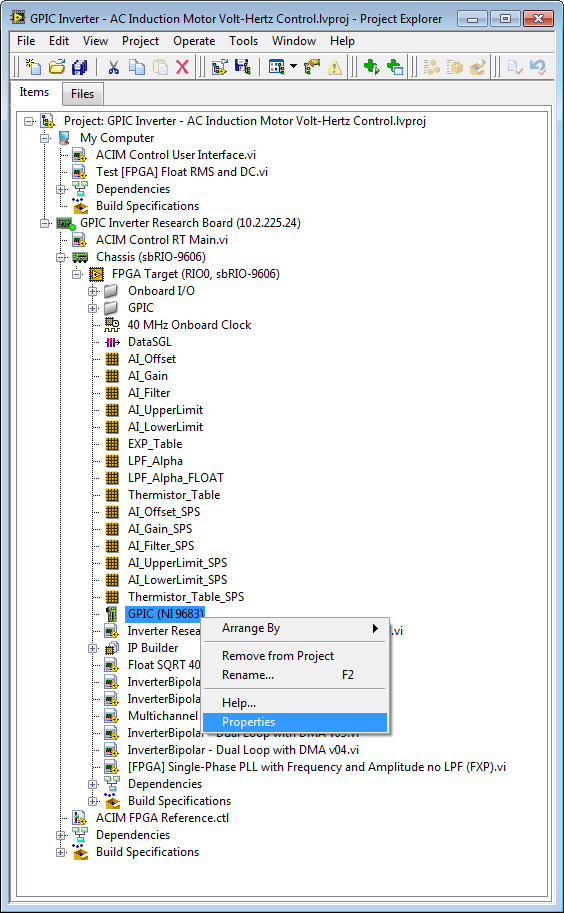
Then configure the input range and scaling mode for the I/O channels and then click OK.
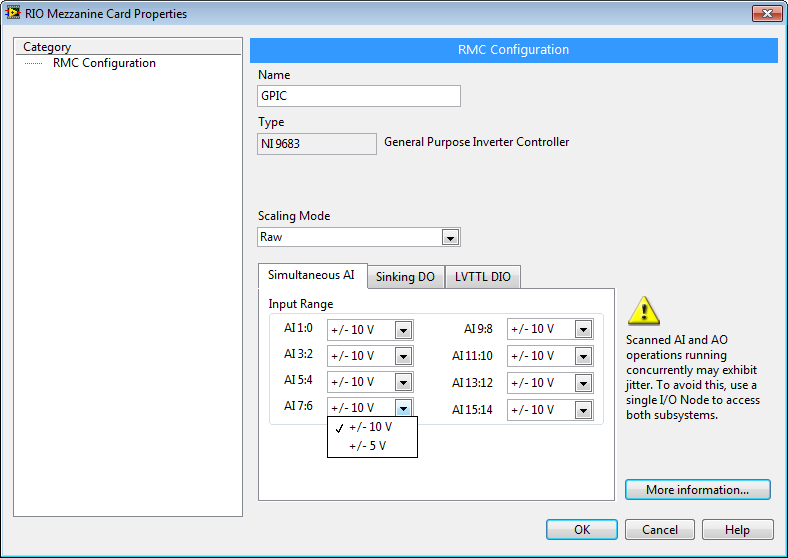
What questions do you have? Please respond and ask them here.
05-02-2013 12:49 PM
- Mark as New
- Bookmark
- Subscribe
- Mute
- Subscribe to RSS Feed
- Permalink
- Report to a Moderator
How does the GPIC compare to cRIO in a design/research capacity where felxibility and prototyping is the main area of interest? Are there benefits the GPIC provides over a cRIO with AO/AI/DIO modules?
